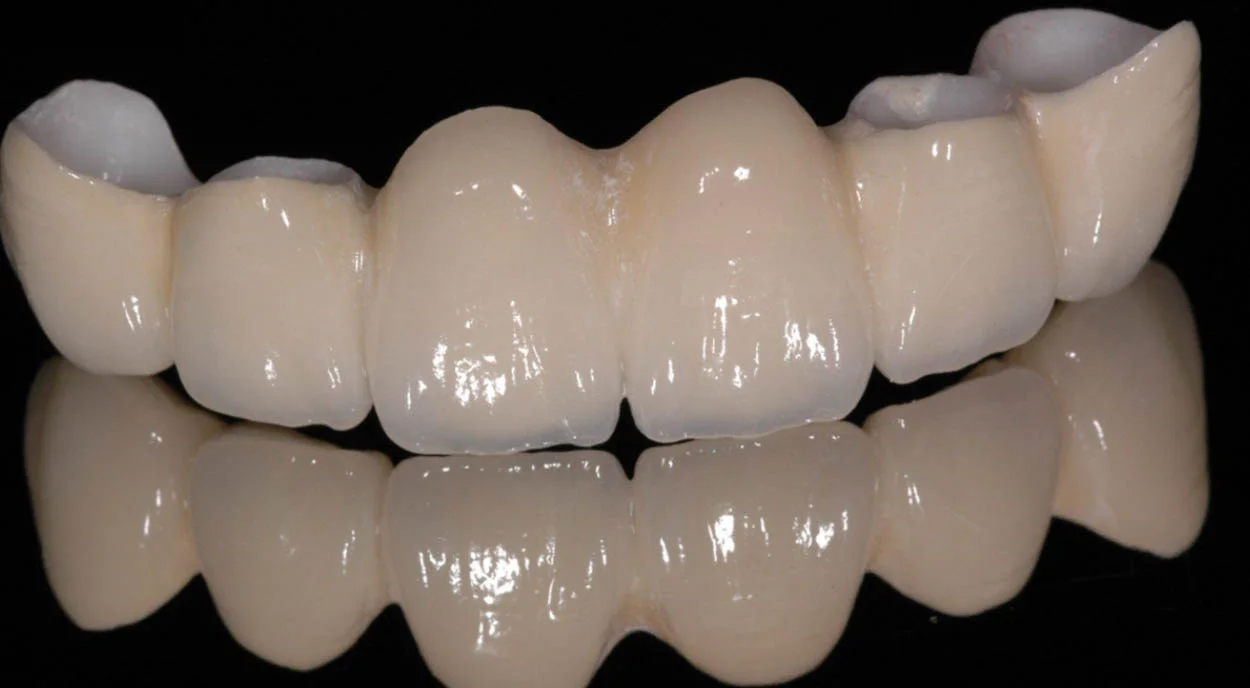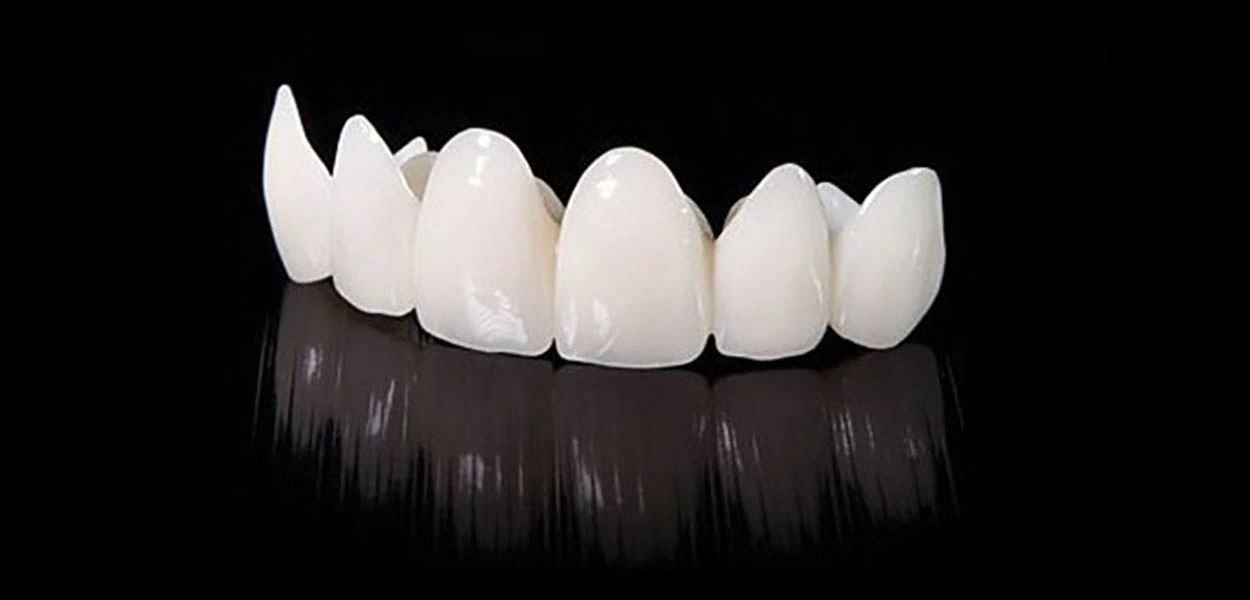The first time I encountered zirconia material was at the IDS exhibition in Germany in 2017. At that time, a colleague pointed to the white porcelain blocks at the booth and said, “This will change the way we approach dental restorations in the future.” Now, eight years later, that statement is becoming a reality.
Zirconium dioxide (ZrO2) is the primary oxide of zirconium, typically appearing as white, odorless, and tasteless crystals that are insoluble in water. It has high hardness, excellent wear resistance, low thermal conductivity, and a low coefficient of thermal expansion. These properties make it widely used in refractories, electronics, aerospace, and ceramics. Today, we’ll focus on zirconia, which is used in dentistry to create all-ceramic crowns, bridges, and other dental restorations.

1. What is The Zirconia Crown?
Zirconia crowns are all-ceramic restorations made from zirconia ceramics. As the newest type of all-ceramic crown in the field of dentistry, zirconia crowns are more natural-looking than traditional metal crowns and cause less interference with CT scans and MRIs.
2. Features of Zirconia Crowns
- The color of zirconia crowns closely resembles that of natural teeth, solving the problems of translucency, black line and discoloration of metal porcelain gingiva. With high aesthetic effect, the light transmittance rate reaches 49%-57%, which is more suitable to be used in areas with high aesthetic requirements;
- Excellent biocompatibility, avoiding the risk of metal allergy. No metal odor in the mouth, no corrosion, no irritation of the pulp nerve due to the alternation of hot and cold. It can withstand high-intensity biting forces, making it durable and resistant to fractures.
- Zirconia used in dentistry has an excellent biosafety profile. A large number of experiments and clinical cases have proved that zirconium oxide has no toxicity damage to bone and soft tissue cells. No allergic reactions have been reported.
- Zirconia does not block X-rays and is non-magnetic, so it has no effect on CT MRI, so there is no need to remove dentures for CT MRI, which saves a lot of trouble.
3. Zirconia All-Ceramic Crown Manufacturing Process
Zirconia all-ceramic dental crowns can be manufactured in two ways: manually and through CAD/CAM CNC precision processing.
Manual Processing Process:
- Tooth preparation
- Dental mold creation
- Substitute mold formation
- Wax-up
- Profiling
- Firing
- Porcelain application
- Porcelain baking
CAD/CAM CNC Precision Processing:
- Tooth preparation
- Dental mold creation
- Substitute mold formation
- Model scanning
- Computer numerical control machining
- Firing
- Porcelain application
- Porcelain baking
The computer numerical control processing of the tooth is closely combined with the natural tooth, so there will not be bacteria breeding in the gap.
Zirconia all-ceramic crowns combine high strength with aesthetic properties similar to those of natural teeth. The bending strength of 900-1400MPa is suitable for anterior and posterior restorations, but prohibited for people with uncontrolled periodontal disease.

4. Advantages and Disadvantages of Zirconia Teeth
Advantages of zirconia teeth
- Natural and beautiful: zirconia’s translucency and layering are close to that of real teeth, especially all-ceramic zirconia restorations, which can highly mimic the color and texture of natural teeth, and are suitable for aesthetic restoration of anterior teeth.
- High strength: the hardness is second only to metal, strong fracture resistance, can withstand large biting force, posterior restorations are not easy to crack.
- Good biocompatibility: metal-free, low irritation to gums, low risk of allergy, high stability in long-term use.

Disadvantages of zirconia teeth
- Possible abrasion of maxillary teeth: zirconia has high hardness, long-term use may accelerate the abrasion of natural teeth. This is particularly a concern for patients with overbites or those who grind their teeth at night, so caution is needed.
- Risk of chipping: If the surface finish is not good, the porcelain layer may flake off and need to be restored.
- Higher cost: Zirconia restorations are more expensive in terms of material and processing costs than traditional porcelain.
Aesthetic and functional balance recommendations
- Anterior restorations: give priority to high-transparency zirconia, which can simulate enamel permeability;
- Posterior restorations: choose high-strength zirconia, but pay attention to the occlusal adjustment, to reduce the damage to the jaw teeth;
- Maintenance hints: avoid biting hard objects, check the wear of the biting surface on a regular basis, and keep the oral cavity clean.
The effect of zirconia restorations is closely related to the doctor’s technique and processing technology, so it is recommended to choose a qualified organization and fully communicate with the doctor about your needs. Dental restoration is not only a functional restoration, but also related to the overall facial coordination, reasonable design can make the smile more natural.
5. True Stories from Clinical Applications
Our client just completed a zirconia crown restoration last week. The patient is a piano teacher with high aesthetic demands. She had been hesitant for years about the problem of gingival black lines associated with traditional metal ceramics, but the translucency and gingival friendliness of zirconium oxide finally assuaged her concerns. However, it is important to note that such delicate restorations require a high level of skill on the part of the dentist, and we have encountered cases where the abutment teeth have loosened due to poor occlusal design.
Hidden Costs Beyond Price
Many patients focus on the $1,000 per tooth price tag, not realizing that maintenance is just as important. Zirconia is very picky about the bonding agent, and we recommend using 3M’s RelyX series. Although the price of a single unit is five times higher than that of an ordinary bonding agent, the five-year follow-up data shows that the rate of restoration loss has been reduced by 72%.
6. Plain All-Ceramic Crowns vs Zirconia All-Ceramic Crowns
| Feature | Regular Porcelain Crown | Zirconia Porcelain Crown |
|---|---|---|
| Material | Traditional porcelain material | Zirconia, a high-strength ceramic material |
| Strength | Relatively low, suitable for posterior teeth but not as strong as zirconia | Extremely high strength, suitable for both anterior and posterior teeth, capable of withstanding larger chewing forces |
| Aesthetic Appearance | Color is close to natural teeth, but may lack translucency | High translucency, more natural appearance, especially for anterior teeth |
| Wear Resistance | Moderate wear resistance | High wear resistance, maintains chewing function over a long period |
| Application | Primarily for anterior teeth or areas with minimal chewing pressure | Suitable for both anterior and posterior teeth, especially for teeth that endure high chewing pressure |
| Cost | More affordable | Relatively expensive due to complex manufacturing process and higher material cost |
| Biocompatibility | Good biocompatibility, unlikely to cause allergies or discomfort | Excellent biocompatibility, suitable for patients with sensitive conditions |
| Repair Difficulty | Repair is relatively simple if damaged, but not as durable as zirconia | Repair is more difficult, but zirconia crowns have greater durability and require less frequent repairs |
| Antibacterial Properties | Regular porcelain crowns have relatively poor antibacterial properties | Zirconia has good antibacterial properties, reducing the likelihood of cavities or oral infections |
7. Precautions
- When wearing zirconia crowns for the first time, patients with mild discomfort should practice using them patiently and gradually adapt to them.
- When wearing zirconia crowns for the first time, patients should eat soft food, and then eat normal food after getting used to it.
- If zirconia crowns are used for restoration of living pulp teeth, avoid eating foods that are too cold or too hot, so as not to cause excitation. After about two weeks, you can eat normally.
- Zirconia crowns will crumble if they are subjected to pressure that exceeds their stress range, so don’t bite foods that are too hard, such as walnuts.
- The occlusal relationship may change after wearing zirconia crowns, so eat slowly and adapt gradually to avoid biting the buccal and lingual mucosa.
- The joints between zirconia crowns and abutment teeth are prone to gather plaque and form tartar, so you should pay attention to keeping your mouth clean, develop the habit of brushing your teeth after meals, flossing between the teeth, and going to the hospital for regular checkups and teeth cleaning.
8. Conclusion
Zirconia dental crown is a mainstream restorative material, both aesthetic and functional. Its color is close to natural teeth, high strength and good biocompatibility, suitable for aesthetic restoration of anterior teeth or restoration of chewing function of posterior teeth. However, it is important to be aware of the risk of wear and chipping of the maxillary teeth and the cost, and should be chosen according to one’s own situation.


